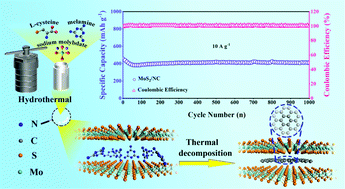Modulation of MoS2 interlayer dynamics by in situ N-doped carbon intercalation for high-rate sodium-ion half/full batteries†
Abstract
In comparison with lithium-ion batteries, sodium-ion batteries (SIBs) have been proposed as an alternative for large-scale energy storage. However, finding an anode material that can overcome the sluggish electrochemical reaction kinetics and fast capacity fading caused by large volume expansion during cycling is problematic. In this study, the intercalation technique for nitrogen-doped carbon layers is implemented for the molybdenum disulfide (MoS2/NC) structure to improve the rate and cycling stability of SIBs by increasing the diffusion rate of sodium ions and mitigating excessive volume structural expansion. The as-synthesized MoS2/NC anode has a high discharge specific capacity of 546 mA h g−1 at 1 A g−1 after 160 cycles, as well as a high rate and stable cycle performance of 406 mA h g−1 at 10 A g−1 after 1000 cycles. Upon coupling with a high-voltage Na3V2(PO4)2O2F cathode, the sodium-ion full battery displays high specific energies of 78.57 W h kg−1 and 49.70 W h kg−1 at specific powers of 193.76 W kg−1 and 3756.80 W kg−1, respectively, with commercialization potential demonstrated.



 Please wait while we load your content...
Please wait while we load your content...